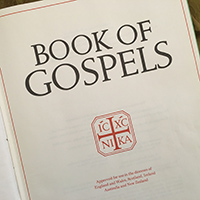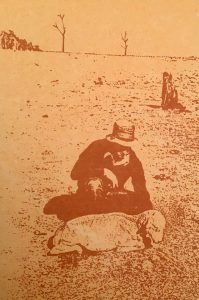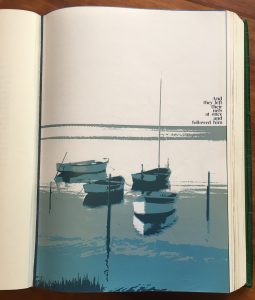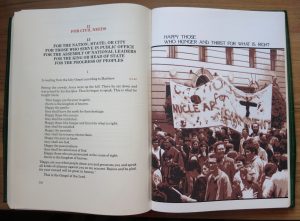 According to ancient tradition in the Church, the Book of Gospels is carried in the entrance procession at Mass, placed on the altar, and then ceremonially taken to the ambo for the proclamation of the Gospel. The Book of Gospels has always been given special respect and dignity in the Church because it is an icon of the presence of Christ to the liturgical assembly.
According to ancient tradition in the Church, the Book of Gospels is carried in the entrance procession at Mass, placed on the altar, and then ceremonially taken to the ambo for the proclamation of the Gospel. The Book of Gospels has always been given special respect and dignity in the Church because it is an icon of the presence of Christ to the liturgical assembly.
Historically, the pages of the Book of Gospels were ornately decorated and bound with an image of Christ or a jewelled cross on the cover. The Book of Gospels has been a treasure for the worshipping community.
In the mid-1980s, I was given the task of illustrating a Book of Gospels for the Sisters of the Good Samaritan. Having been presented with an unbound copy of the 1982 edition of the Book of Gospels, my challenge was to give this sacred book a particularly Australian feel and character.
 At the time, I was studying Visual Arts at Sydney College of the Arts and learning the skills of printmaking, particularly silkscreen printing; so I decided to illustrate the Book of Gospels with screen-printed images from photographs provided by the sisters themselves. A request was sent out to the various Good Samaritan convents around Australia and photographs were sent to me from far and wide. These photographs expressed much of the Australian spirit and landscape.
At the time, I was studying Visual Arts at Sydney College of the Arts and learning the skills of printmaking, particularly silkscreen printing; so I decided to illustrate the Book of Gospels with screen-printed images from photographs provided by the sisters themselves. A request was sent out to the various Good Samaritan convents around Australia and photographs were sent to me from far and wide. These photographs expressed much of the Australian spirit and landscape.
One of the sisters, for example, had managed to source newsroom photographs of the Ash Wednesday bushfires and of exhausted emergency service volunteers. Another sister sent me a photograph of her own sister nursing her newborn child. Others sent images such as grevillea dripping with morning dew or sunlight shining through the branches of a tree. One image was a stark windmill in a dry Australian landscape. Photographs also included indigenous children, young boys in a school playground, a drought-stricken farmer tending his dying sheep, ‘Catholics for Peace’ gathered for the Palm Sunday peace rally, an old man praying, and a photograph from the 1920s of one sister’s family on their way to Sunday Mass.


These many varied photographs needed to be sorted and the most suitable ones selected to illustrate the seasons of the Church’s liturgical year. The images had to be symbolic not only of the Australian spirit but of the deep mystery of the Incarnation – the life, death and resurrection of Jesus Christ. While the images are not explicitly religious, we are still able to see echoes of the Paschal Mystery in the undercurrent of everyday life, in the dying and rising of nature, in droughts and bushfires and the regeneration of the landscape, in the struggles and joys of our human lives. This is what I hoped would be reflected in the illustrated pages of the Good Samaritan Sisters’ Book of Gospels.
The process of transferring the photographs to silkscreen was complex. The result was that the images took on a slightly abstract and ‘pared back’ appearance; yet we can still discern the basic form of the original photographs. Looking through this Book of Gospels today, thirty-six years since the screen-printed pages were created, I have an overwhelming sense that it is a very humble offering to the Sisters of the Good Samaritan. If I were given the task today, I would approach it very differently. However, I know the sisters still treasure it and use it for all the major celebrations of the liturgical year as well as for funerals of the sisters who have died.
 Of the many illustrations in the book, there are three I will feature here. The first is the page for Midnight Mass at Christmas. It features the print of a grevillea flower laden with fresh morning dew. Each frond of the flower seems to be unfurling in the morning light, like a new creation, a newborn child. It is an image of fresh beginnings. The text of the Christmas antiphon beneath the image amplifies its meaning
Of the many illustrations in the book, there are three I will feature here. The first is the page for Midnight Mass at Christmas. It features the print of a grevillea flower laden with fresh morning dew. Each frond of the flower seems to be unfurling in the morning light, like a new creation, a newborn child. It is an image of fresh beginnings. The text of the Christmas antiphon beneath the image amplifies its meaning
Let us all rejoice in the Lord,
for our Saviour is born to the world.
True peace has descended from heaven.
 The second image heralds the season of Lent for Year B. It is a dramatic photograph of the 1983 Ash Wednesday bushfires in Victoria. It is an image of devastation that gives us pause for reflection. Fire destroys everything in its path. It also cleanses and allows the bushland to regenerate after the intense flames have swept through. The image acts as a symbol for suffering – our own human suffering as well as the suffering and death of Jesus Christ – which holds the seeds of resurrection.
The second image heralds the season of Lent for Year B. It is a dramatic photograph of the 1983 Ash Wednesday bushfires in Victoria. It is an image of devastation that gives us pause for reflection. Fire destroys everything in its path. It also cleanses and allows the bushland to regenerate after the intense flames have swept through. The image acts as a symbol for suffering – our own human suffering as well as the suffering and death of Jesus Christ – which holds the seeds of resurrection.
 The third image belongs to the gospel readings for civil needs. It features a large group of ‘Catholics for Nuclear Disarmament’ marching at a Palm Sunday peace rally in Melbourne in the early 1980s. The image sits alongside the gospel of the Beatitudes and illustrates our Christian longing for peace and justice. The image is a living example of the gospel being taken to the streets.
The third image belongs to the gospel readings for civil needs. It features a large group of ‘Catholics for Nuclear Disarmament’ marching at a Palm Sunday peace rally in Melbourne in the early 1980s. The image sits alongside the gospel of the Beatitudes and illustrates our Christian longing for peace and justice. The image is a living example of the gospel being taken to the streets.
This Book of Gospels is a product of its time. It is a fragment of history that reflects something of Australia in the 1980s. Throughout the liturgical year, it invites us to ponder our relationship to God’s living word revealed in the life, death and resurrection of Jesus Christ and in the daily struggles and joys of our own lives. May the Sisters of the Good Samaritan continue to find in this simply illustrated Book of Gospels an icon of the presence of Christ in their midst. May it encourage Church communities today to craft beautiful books with original liturgical art to enhance the sense of the sacred in the celebration of their liturgy.
Tricia Murray is a teacher and artist with connections to the Good Samaritan Sisters. She has worked in the Melbourne liturgy office in art and design.
